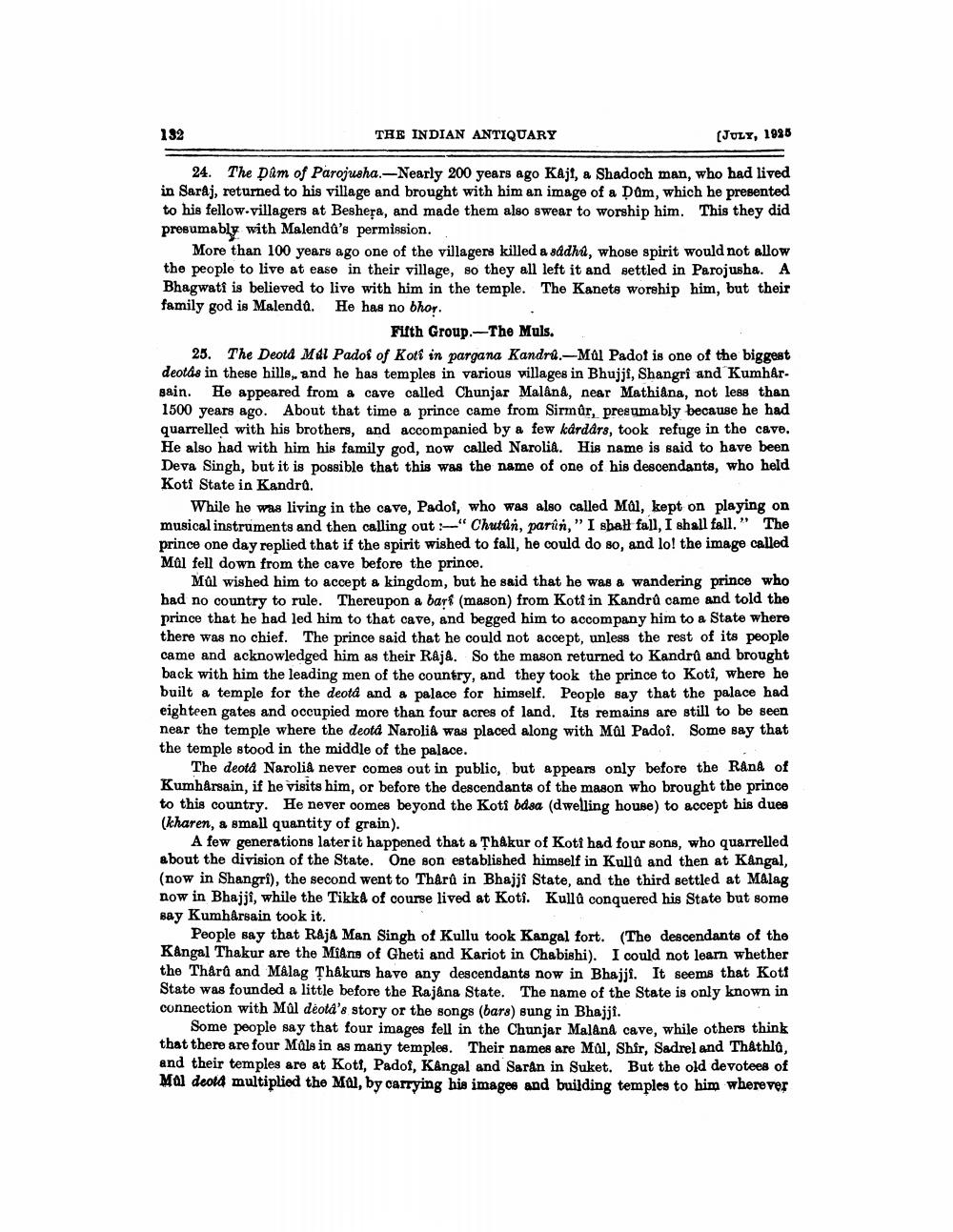________________
132
THE INDIAN ANTIQUARY
(JULY, 1995
24. The Dam of Parojusha.-Nearly 200 years ago Kajt, a Shadoch man, who had lived in Saraj, returned to his village and brought with him an image of a Dam, which he presented to his fellow.villagers at Beshera, and made them also swear to worship him. This they did presumably with Malenda's permission.
More than 100 years ago one of the villagers killed a sddhi, whose spirit would not allow the people to live at ease in their village, so they all left it and settled in Parojusha. A Bhagwati is believed to live with him in the temple. The Kanets worehip him, but their family god is Malenda. He has no bhor.
Fifth Group.-The Muls. 25. The Deotd Mal Padof of Koti in pargana Kandri.-Mal Padot is one of the biggest deotas in these hills, and he has temples in various villages in Bhujji, Shangri and Kumhår. gain. He appeared from a cave called Chunjar Maland, near Mathiana, not less than 1500 years ago. About that time a prince came from Sirmûr, presumably because he had quarrelled with his brothers, and accompanied by a few kárdárs, took refuge in the cave. He also had with him his family god, now called Narolia. His name is said to have been Deva Singh, but it is possible that this was the name of one of his descendants, who held Koti State in Kandrů.
While he was living in the cave, Padof, who was also called Mai, kept on playing on musical instruments and then calling out :-"Chutan, parin," I sbal fall, I shall fall." The prince one day replied that if the spirit wished to fall, he could do so, and lo! the image called Mal fell down from the cave before the prince.
Mal wished him to accept a kingdom, but he said that he was a wandering prince who had no country to rule. Thereupon a bari (mason) from Koti in Kandru came and told the prince that he had led him to that cave, and begged him to accompany him to a State where there was no chief. The prince said that he could not accept, unless the rest of its people came and acknowledged him as their Raja. So the mason returned to Kandrů and brought back with him the leading men of the country, and they took the prince to Koti, where he built a temple for the deota and a palace for himself. People say that the palace had eighteen gates and occupied more than four acres of land. Its remains are still to be seen near the temple where the deot Narolid was placed along with Mal Padoi. Some say that the temple stood in the middle of the palace.
The deota Naroliâ never comes out in public, but appears only before the Rånå of Kumhársain, if he visits him, or before the descendants of the mason who brought the prince to this country. He never comes beyond the Koti bdsa (dwelling house) to accept his dues (kharen, a small quantity of grain).
A few generations later it happened that a Thakur of Koti had four sons, who quarrelled about the division of the State. One son established himself in Kulla and then at Kångal, (now in Shangri), the second went to Tharû in Bhajji State, and the third settled at Malag now in Bhajji, while the Tikka of course lived at Koti. Kullû conquered his State but some Bay Kumharsain took it.
People say that Raja Man Singh of Kullu took Kangal fort. The descendants of the Kangal Thakur are the Mians of Gheti and Kariot in Chabishi). I could not learn whether the Thara and Malag Thákurs have any descendants now in Bhajji. It seems that Kotf State was founded a little before the Rajana State. The name of the State is only known in connection with Mal deotd's story or the songs (bars) sung in Bhajji.
Some people say that four images fell in the Chunjar Malana cave, while others think that there are four Mals in as many temples. Their names are Mol, Shir, Sadrel and Thâthla, and their temples are at Koti, Padoi, Kangal and Saran in Suket. But the old devotees of Mal deotd multiplied the Mal, by carrying his images and building temples to him wherever




